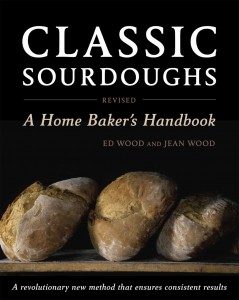Revised Classic Sourdoughs by Ed and Jean Wood is an entirely different book. Different in many ways but especially in describing how the baker uses changes in temperature and proofing times to influence the flavor and quality of the crumb. They advocate three entirely different proofs : first of the fully active culture, then of the dough and finally of the loaf to produce the final product. The time and temperature of each gives the baker three opportunities to change the final result as desired. The revised book shows how to make a proofing box from a Styrofoam cooler with a light bulb equipped with an ordinary dimmer switch for accurately regulated temperatures to produce sharper flavors and better texture when the right temperature is used at the right time.
They will lead you into a better under standing of the fermentation process in which higher temperatures increase the activity of the bacteria but inhibit the wild yeast which allows the baker to closely control flavor and leavening. You will become convinced that 1 quart glass canning jars are by far the best containers to house your cultures since each time you feed them the lactobacilli make them slightly more acidic. In time this makes the cultures too acidic and inhibits both organisms. The 1 quart jars require discarding some of the mixture each time they are fed or the jars will overflow. This helps to keep the cultures from becoming too acidic. Larger containers do quite the opposite, discarding is not required and the cultures become too acidic.
The Woods use unbleached all-purpose flours which they think produce equal or better sourdough breads than flours from hard red winter or spring wheat. In addition for better “oven spring” Ed, for most of his baking, puts the loaves in a cool oven, sets the temperature to around 375° and only then turns it on.
The 215 page book has more than 90 recipes using ingredients and directions for flax, soy flours, kamut, spelt, organic flours and others. These grains all produce fabulously different sourdoughs.
The Authors’ qualifications
Ed is an M.D. pathologist with a background in baking. He received a Ph. D. at Cornell where he studied under Dr. Clive McCay one of the foremost pioneers in early nutrition research. In 1983 he became Chairman of Pathology in a new hospital near Riyadh, Saudi Arabia. He had long been fascinated with the organisms that produced man’s bread for 5,000 years. Knowing that the Middle East was the historic birthplace of bread he and Jean began a quest for sourdough cultures passed through generations of bakers from the beginning of civilization that had never used commercial yeast. Their adventures, ranging from the humorous to the serious produced a collection of sourdough cultures and recipes from around the world dating back to antiquity. Four years and hundreds of experiments later he and Jean with her degree in Pharmacy produced the first book on the science and art of sourdough baking.
In 1993 they collaborated with Egyptologist, Dr. Mark Lehner, to determine how man made his first leavened bread. National Geographic Magazine, January, 1995. In the process they captured a wild culture which Ed says dates straight back to antiquity. He named it “La Giza”and says she is the Queen of the pyramids and older than all of them combined.
On the night of October 12, 2010, Jean lost a contest with a cerebral aneurism and died instantly. Ed and Ten Speed Press chose to dedicate this revised edition of Classic Sourdoughs to the one person most responsible for its production.



